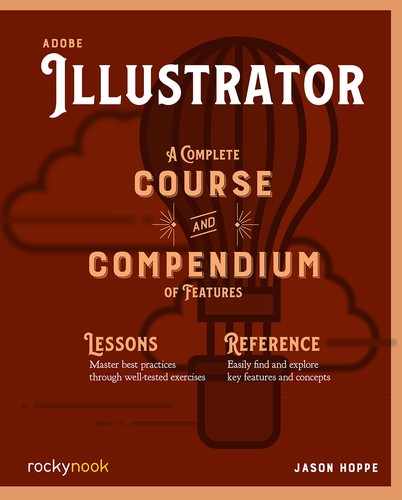Effects Menu
Raster and Vector Effects
The Effects menu in Illustrator has a list of effects that can be a applied to text, objects, or layers. The Effects menu is divided into two sections. The first section is labeled Illustrator Effects. These are effects that are applied to vector artwork such as objects, paths, strokes, and fills. The second set is labeled Photoshop Effects. These effects can be applied to either vector or raster objects. Not all the effects listed under Illustrator Effects are strictly for vector objects; 3D effects, SVG Filters, Warp effects, Transform effects, Drop Shadow, Feather, Inner Glow, and Outer Glow can be applied to both vector and raster objects.
Apply an Effect
Select an object and choose an effect from the Effects menu. Once the effect is applied it will appear in the Appearance panel. Effects can also be applied from the Appearance panel by clicking on the ![]() button and choosing from the list of effects.
button and choosing from the list of effects.

Modify or Delete an Effect
To edit the effect, click on the Effect link in the Appearance panel.

If you select the same effect from the Effect menu with the intent to edit the original, a dialog box will appear warning you that this method will create the same effect twice on the same object. By clicking on Apply New Effect, you will see another instance of the same effect appear in the Appearance panel.
To delete an effect, select the effect in the Appearance panel and click the Delete button.
To turn off the effect but not delete it, click on the eye to the left of the Effect.
Applying Multiple Effects

Multiple effects can be applied to an object, stroke, or fill in the Appearance panel. Select the object name at the top of the Appearance panel to apply an effect to the entire object. Click on the path or fill to apply the effect.
When effects are applied, they build on each other. Each effect will affect the previous effect. In this example, the Zig Zag Effect was applies first, the Roughen Effect second, the Twist Effect third, and the Drop Shadow Effect last.
The order of the effects can be changed by dragging them up or down the list, which will change the look of the object.
Scaling Effects
When effects are applied to an object, the default in Illustrator is that the effects do not scaled with the object. If an object is scaled with an effect, the effect will be distributed over the entire object, but it will not scale with the object. To turn on the Scale Stroke & Effects as needed, click the box in the Transform panel. To change the default settings of this feature, choose Illustrator > Preferences > General (Mac) and select Scale Strokes & Effects or choose Edit > Preference > General (PC).

When the Scale Stroke & Effects is turned off, the object can be scaled. The stroke weight will remain the same and the effects will be distributed over the entire shape. The appearance of the effect may change as the object is scaled larger or smaller and may look quite different from the original shape. With Scale Stroke & Effects turned on, the effects and stroke will scale in proportion to the original shape. This will keep the same look of the effect when the object is scaled, keeping the object consistent.
